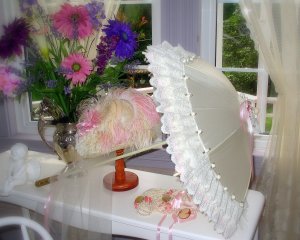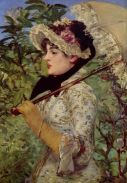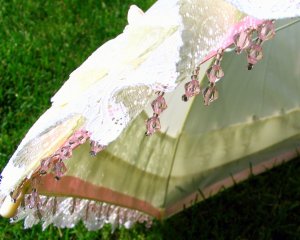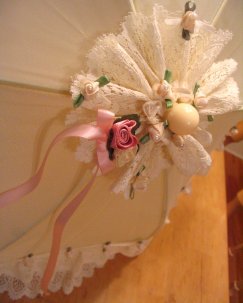Almost everyone has used an umbrella on a rainy day. I can remember a time when it was part of the back to school arsenal, we all had to walk, either to the bus stop or to the school, and it didn’t matter what the weather was like. My mother didn’t have the luxury of a car in the driveway for many years, as with most families my father took it to go to work each day. That meant we had to walk to school, no rides, so…we all owned rain gear, rubber boots and umbrellas.
Parasols were a somewhat different matter and weren’t used as much, particularly not individually or in this part of the world. Of course, most of us likely own a patio umbrella or a beach parasol. In other parts of the world however, individual parasols are and always have been very popular and in history they were a staple of the fashion industry.
Parasols and umbrellas are truly ancient and have been used for thousands of years to protect their users from both the sun and the rain. Sculptures and Pictograms of the very early civilizations display the use of parasols, particularly by the upper classes and royalty. They were made of various materials including feathers, palm leaves, bamboo and paper. In China they were even collapsible and lacquered or waxed making them somewhat water repellent. In Egypt tanned skin was unfashionable and the upper classes shielded themselves from the sun. Parasols were used in India, Assyria, Persia and Greece, as early as 1200 BC by high ranking noblemen and were generally carried by their servants.
By the early 16th century parasols had made their way to Europe, most likely through trading routes, and via the silk road. They became very popular with church dignitaries and were soon-after adopted by the European gentry. There is some speculation that the halos seen above religious figures in various paintings, may actually have been the addition of a misunderstood parasol.
During the following centuries the parasol became a very popular fashion item, they very much belonged to the realm of high society women, whose pale and untanned skin was the signature of their rank. They became small, light and collapsible so there was no longer the need for a servant to carry them.
In the 18th century a parasol completed a woman’s outfit, just as a hat, handbag and shoes might. They were made of cotton, silk and adorned with lace, braid, satin, beading and an assortment of other various trims. The handles were long or shorter, the covers small or larger, it all depended on the era and the fashion trends of the day. From what I have seen, the handles were made of wood and decorated with ivory, mother of pearl and even gold and silver. Not only did they protect these ladies from the sun, but they were also used as a means to flirt, and even as a handy way to protect them from unwanted advances.
When my research was completed, I knew I needed to add the historical parasol to the accessories list for the ladies’ gowns, “The Passage to India” and “An English Rose”. There are many beautiful parasols available, and the sky is really the limit, but I was looking for a particular style. I wanted a small covering and longer handle. After much searching I found just what I was looking for, in a variety of colours and at a reasonable price. They were however unadorned so…I would have to decorate them myself. I purchased two, a black one and an ivory one.





